The Poinsettia, or Poinsettia pulcherrima by its full name, is also known as the Winter Rose and belongs to the Euphorbia family. It is often regarded as a once-off seasonal shrub bought before Christmas.
It is the holiday season plant. With its iconic red bracts around the yellow flowers, it is a popular choice for both festive decorations and gifts in the US. Decorate your doors with a poinsettia wreath as we used to do, or keep it inside as a houseplant.
Poinsettia care is not easy, and I forgive everyone who manages to keep it alive during the holiday season.
Table of Contents
Poinsettia Care Takeaways
| Species | Poinsettia pulcherrima |
| Synonyms | Euphorbia pulcherrima,Christmas Rose Winter Rose Poinsettia,Poinsettia,Christmas flower,None |
| Family | Euphorbiaceae |
| Genus | Poinsettia |
| Growth | Upright growth |
| Height | 13 feet |
| Width | 7 feet |
| Soil | Well-draining loose, porous, and acidic soils |
| Watering | Water every 5 to 7 days |
| Light | Bright indirect light |
| Temperature | 60 to 70°F |
| Humidity | 50-75% |
| Fertilizer | Fertilize 1 time per month |
| Propagation | Stem cuttings |
| Toxicity | Non-toxic to humans and animals such as cats and dogs. Ingestion can have mild effects such as diarrhea, vomiting, and nausea. |
Poinsettia Care
To care for Poinsettia provide it with bright indirect light and well-draining loose, porous, and acidic soil. Water about once a week and provide temperatures between 60°F to 70°F (15.5°C to 21°C). The ideal humidity is between 50-75%. Fertilize once a month using a water-soluble houseplant fertilizer.
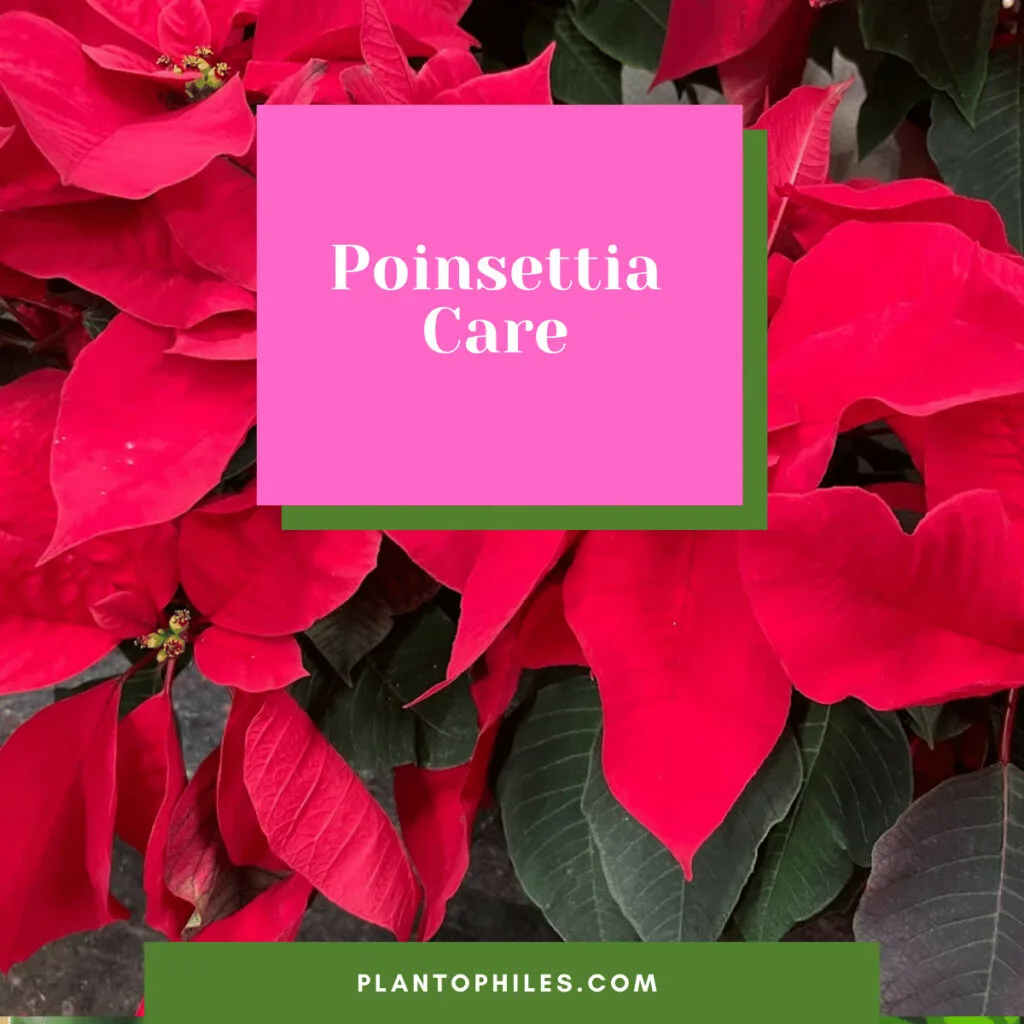
My Poinsettia Care Tips And Growing Guide
Soil
Prefers well-draining loose, porous, and acidic soils. This is not a plant to enjoy sitting in excess water. It requires a soil type that is well-draining. The pot needs extra drainage. Drainage holes are a must. A good soil option for your Winter Rose is premixed pasteurized soil.
Light
The Poinsettia thrives in bright indirect sunlight. Ideally, your Winter Rose should be exposed to light for six hours daily.
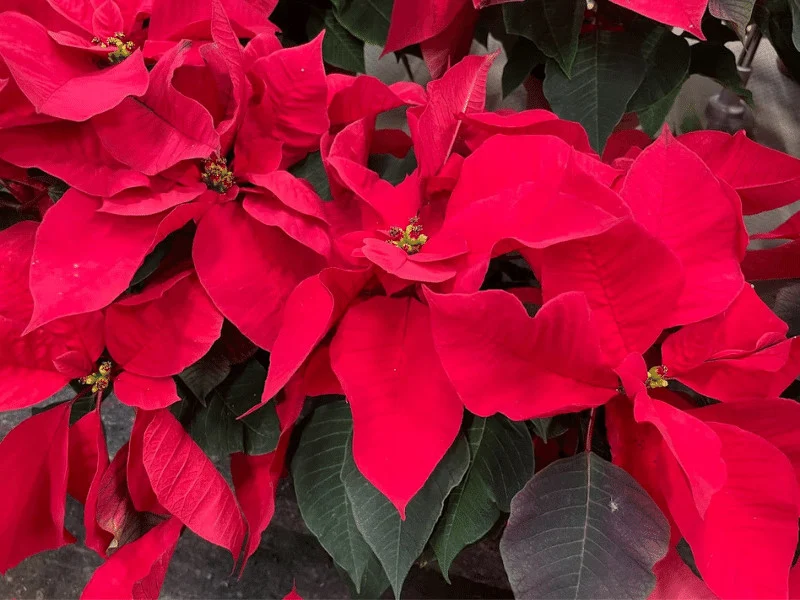
Watering it just right
Water weekly when the top 1 inch of soil feels dry to the touch (2.5cm). The Winter Rose should never be overwatered. It hates wetness. So avoid soggy potting soil.
Wet soil is something to avoid generally with indoor plants.
These shrubs prefer an average moisture level in their soil but not enough to feel drenched.
Allow time between watering sessions for your plant’s topsoil to dry out slightly.
Before watering, it is recommended that you test the soil moisture by placing your finger about 1 inch into the soil (2.5cm). Water only if the top 1 inch is completely dry about once a week.
Doing so will allow you to feel and judge whether or not your Winter Rose needs more water without risking your plant’s health.
Only watering your plant when it needs a drink will reduce the risk of root rot.
Too little water will result in your Christmas star to be wilting and its lower leaves drooping. Too much water may cause your plant’s lower leaves to turn yellow and droop.
A good tip for watering a Poinsettia is to water it deeply only when needed. Allow excess water to drain from the soil into the pot’s saucer.
Always discard the excess water. It should never be left to sit with water in its pot’s saucer.
When watering, avoid wetting the plant’s leaves. Make sure you strictly water around the base of your Winter Rose.
Read all about how often a poinsettia needs water.
Temperature
These shrubs should be kept in temperatures between 60°F to 70°F (15.5°C to 21°C) during the day. At night, temperatures of at least 55°F ( 12.7°C) are required. Christmas stars are not frost-hardy.
Exposure to temperatures that are either too hot or too cold for the Winter Rose will cause harm to it. The plant’s leaves will face damage with too cold a temperature and are likely to drop. Too high of a temperature will shorten the plant’s bloom time.
It is best to keep these shrubs away from areas where they may be exposed to drafts or appliances that are used to give off heat.
Read more about how cold Poinsettias can tolerate.

Humidity
The ideal humidity for a Poinsettia is between 50-75%. The Christmas star loves increased humidity, according to Purdue University.
The Right Location
The ideal location is a south-, east-, or west-facing window where the plant receives bright indirect light.
However, the Christmas star is a short-day, long-night type of plant.
They need longer periods of complete darkness to change their colors. Preferential climate zones for the Winter Rose are USDA Hardiness zones 9 to 11.
If your plant is placed by a window, you must ensure the plant’s leaves do not make contact with the cold glass of the window.
Contact with the window’s glass will chill the plant’s leaves and can damage it.
Avoid heating vents as well.
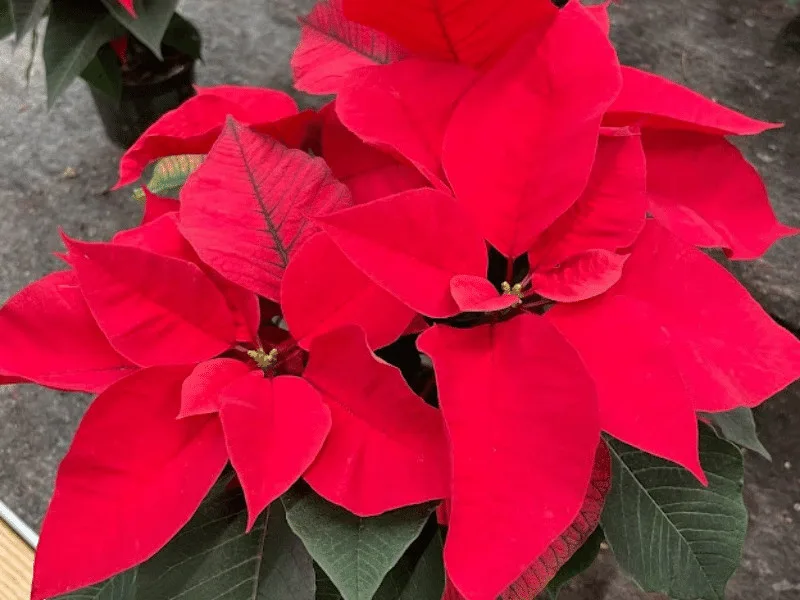
Christmas Star Maintenance so You can Grow it as the Perennial it is
The Christmas star does not require much pruning. This is because most plant owners discard them before the winter months or at the close of the festive season.
However, if kept as a perennial, the Winter Rose does need to be trimmed and repotted.
Winter Rose should be trimmed right down to just above the soil line to continue growth.
Trimming the stem of your Christmas star down until it is about 4 inches (10cm) above the soil is recommended. Following this, repotting your shrub is advisable.
Remove your newly trimmed Winter Rose from its pot and remove as much remaining soil as possible.
Be gentle with your plant. Replace your shrub in a new pot or its original one with fresh soil.
Finally, you will need to water your Christmas star deeply twice.
First, soak your plant’s soil completely and allow it to drain for a few minutes. Then water it once more. Be sure to discard any excess water caught in the pot’s saucer.
Fertilizer
A general-purpose, houseplant fertilizer that is water-soluble and applied once a month is ideal. Do not fertilize when the Winter Rose is in bloom.
Propagation
Propagation through stem cuttings. Although possible, it is a rather difficult plant to propagate.
Poinsettia Pests and Diseases
These plants are prone to different issues and insects. Many of these are a result of either over-watering or under-watering your Poinsettia.
Issues you may experience with the Winter Rose due to improper watering include root rot, leaves wilting, yellow leaves, drooping, or even dropping off and white marks. White marks on your plant is a result of water dropping on it.
Pests known as nuisance include fungus gnats, spider mites, mealybugs, and whiteflies.
Read about the best tips on what to do when your Poinsettia is dying here.
Poinsettia history
The Christmas Star is the most popular indoor and flowering plant sold in the United States. This is even though it is only available for roughly six weeks of the year.
U.S. Ambassador Joel Robert Poinsett is this shrub’s namesake. He was the first to have brought the plant into the United States.
The introduction of the Winter Rose occurred back in 1825. Poinsettias plants have gained so much popularity over time that they even have their national day! December 12th is known as National Poinsettia Day.
Poinsettia Appearance
Winter Rose plants are magnificent, with their colorful red bracts elegantly laid atop deep green leaves. The bracts are just a modified leaf, as a botanist would say.
When you care for the plant correctly, new growth in the form of leaves, bracts, and flowers emerges.
It is a common misconception that these bracts or leaves are the plant’s flower petals. The Winter Rose’s flowers are small and quite inconsequential.
The real flowers of this shrub are located on the inner part of the plant, known as the cyathia. Cyathias can be found in the center of each group of bracts.
This is the small yellow part on the inside of the plant, which holds the plant’s pollen. Unfortunately, despite pollen, the Winter Rose Poinsettia is not one to attract pollinators.
Once the Poinsettia has shed its pollen, the leaves will begin falling off. It is typical for the colored leaves to be the first to fall off. The plant’s regular green leaves then follow this.
Although red is typically the most popular color, Poinsettia plants are available in various colors.
Other color variations include pink, white, marbled, yellow, and orange. Growing in popularity are the pink, white and marbled variations.
Other than their vibrant coloring, the bracts of the Winter Rose have another point of interest.
This is their shape. Interestingly, the bracts of the Christmas star appear much like a gathered seam as they curl under.
These plants grow to resemble a very rose-like bloom. This resemblance and the shrub’s season of interest were combined to create its common name, Winter Rose.
Different Christmas star color variations
Poinsettia Size
Poinsettia plants grow between 13 feet in height (4m) and roughly 7 feet in width (2m).
Growth
With an upright growth habit and a slow-growing reputation, the Winter Rose is generally gifted once they have already been grown.
Typically, these shrubs are discarded once the festive season has come to a close. This is due to the misconception that the Christmas star is a purely seasonal plant when they are capable of being perennial with proper care.
When cared for as a perennial, the Winter Rose Poinsettia maintains its season of interest during winter.
Uses for Poinsettia
Poinsettia plants have a history, if not a legacy, as being the flowers of Christmas. They are extremely popular as festive decorations and make up a major part of many floral Christmas displays. Winter Rose Poinsettia shrubs are also a favored gifting option.
These shrubs can even be trained to grow as small trees. Poinsettia pulcherrima makes for gorgeous statement pieces in entryways or any location in your home.
Where to Buy Poinsettia
You can buy a Christmas star at the following retailers: Amazon, Home Depot, and Waitrose.
The University of Illinois has a thorough checklist to ensure you buy a healthy Poinsettia plant.
Poinsettia Toxicity
The Christmas star is non-toxic to humans and animals such as cats and dogs. Ingestion can have mild effects such as diarrhea, vomiting, and nausea, according to Poison.org. The best is to keep this plant away from pets. It produces a visible white sap once the plant stem is damaged or cut.
Read more about is Poinsettia is toxic to cats.
Poinsettia Care After Christmas
Poinsettia is a perennial and can bloom again next year. If kept alive. For this to happen, the plant needs to be cut back about 4 inches (10cm) and kept at a temperature of 55 degrees Fahrenheit (13°C) until April.
Repot the plant in May and keep it somewhere cool over the summer. You can grow it outside during this season. Fertilize monthly and water it weekly. Prune the top branches and shoots to make the plant bushier.
Then in November, it is time to make the poinsettia bloom again. Ensuring it gets 12 hours or less of sunlight. Artificial light is fine as well. The longer nights will initiate the reblooming. But avoid cold drafts close to windows.
Colors
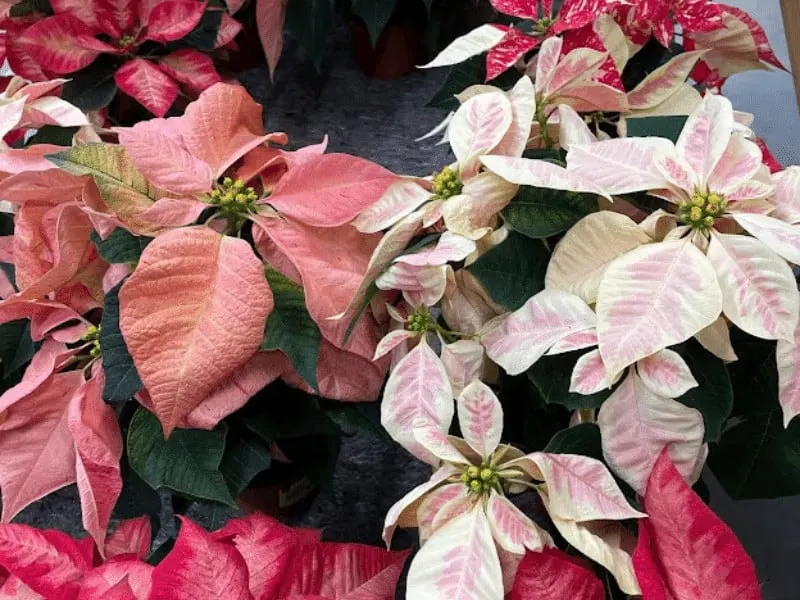
Poinsettias come in many colors. Their bracts are available in red, white, pink, and various variations and color mixes. You will also see plants with sprinkled golden or silver glitter on them. This is not natural and has been applied by the growers.
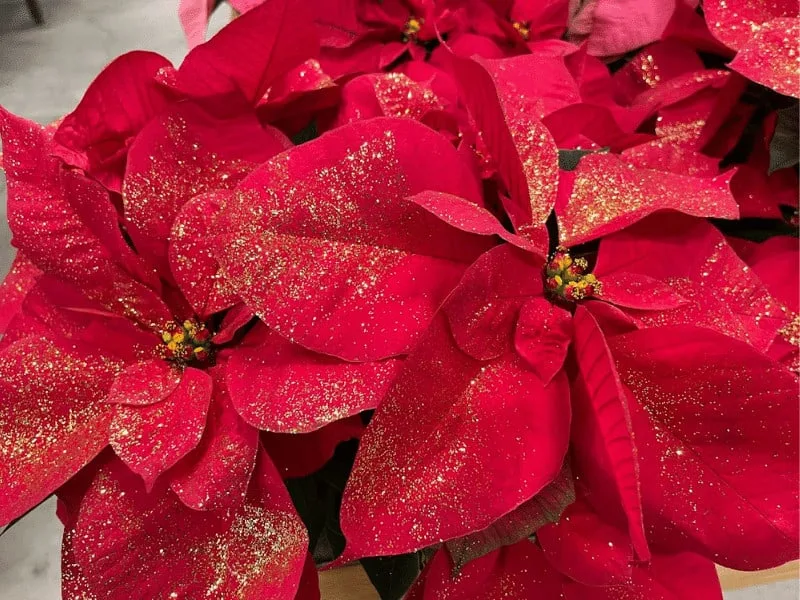
Frequently Asked Questions
Are Poinsettia plants poisonous?
It is a misconception that the Poinsettia is more than a mildly poisonous plant. The shrub produces a milky sap it is only likely to cause skin irritation to some people, especially those who are allergic to latex. Even if a human or animal ingests the plant, the result is only mild stomach discomfort.
Does the Poinsettia only bloom once?
A misconception about the Poinsettia is that it only has a lifespan of around six weeks. Although this is partially true, people do not realize that the Winter Rose Poinsettia is a perennial plant and can be encouraged to bloom again. This requires proper care, however, and many people find it easier to just discard the plant and purchase a new one the following festive season.
Can the Winter Rose Poinsettia be grown in water?
The Poinsettia is not a shrub capable of being grown in water.
Conclusion About Poinsettia Care
To care for this Poinsettia, provide:
- Light: Bright indirect light
- Soil: Well-draining, loose, porous, and acidic soil
- Temperatures: 60°F to 70°F (15.5°C to 21°C)
- Humidity: 50-75%
- Watering: once a week
- Fertilizer: Once a month with a water-soluble houseplant fertilizer

Daniel has been a plant enthusiast for over 20 years. He owns hundreds of houseplants and prepares for the chili growing seasons yearly with great anticipation. His favorite plants are plant species in the Araceae family, such as Monstera, Philodendron, and Anthurium. He also loves gardening and is growing hot peppers, tomatoes, and many more vegetables.


